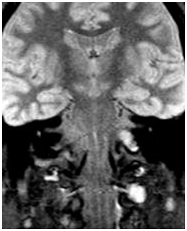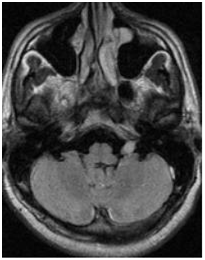International Journal of
eISSN: 2574-8084


Neurolemmomas are benign nerve sheath tumours with extra vestibular cranial nerve involvement being very rare, rarest of them being hypoglossal nerve (cranial nerve XII). We report the case of a hypoglossal nerve shcwannoma with extra cranial extension.
Keywords: neurolemmoma, hypoglossal nerve
A hypoglossal nerve neurolemmoma might present as hypoglossal nerve palsy, muscle atrophy of tongue but sometimes may be asymptomatic initially. Early diagnosis may be achieved with detailed neurological examination and only a strong suspicion leads to a targeted imaging.
Neurolemmomas (schwannoma, neuromas, neurilemmomas) are benign tumours originating from Schwann cells or nerve fibre sheath cells. Neurolemmomas of the hypoglossal nerve are exceedingly rare with less than 100 documented cases. Exact incidence is not available. Neurolemmomas of the hypoglossal nerve usually develop in the intracranial portion or both in the intracranial and the extra cranial components forming a dumb-bell shape. We present a case which on magnetic resonance imaging presented as an intensely enhancing posterior fossa mass with extension into the carotid space up to the carotid bifurcation.
A 40 year old male presented with recent onset of slurring of speech and fissuring of tongue. On examination he was found to have fasciculation’s of left side of tongue, weakness and wasting of the left side tongue muscles. Rest of the cranial nerves functions were normal. Clinically a diagnosis of left hypoglossal nerve palsy was made. Laboratory data was normal.
The brain magnetic resonance imaging showed an intensely enhancing lesion (approximately 6 x 1.5cm) arising from left hypoglossal canal and progressing anterolateral to clivus to descend inferiorly within carotid space displacing internal carotid artery and closely abutting internal jugular vein. The lesion was seen to extent inferiorly up to level of carotid bifurcation (C2 level).
Secondary evidence was derived from the demonstration of atrophy of muscles on the left side of the tongue, which helped in clinching the diagnosis of the causative factor to be hypoglossal nerve mass lesion, with radiological features in favour of neurolemmoma (Figure 1–4).

Figure 1 STIR coronal images showing a hyper intense lesion arising from the medulla on the left side at the region of hypoglossal canal. Left hypoglossal nerve not visualized separately.

Figure 2 FLAIR axial images at the level of middle cerebral peduncle show a hyper intense signal in the region of left hypoglossal canal.
Neurolemmomas are benign nerve sheath tumours. They constitute to about 8.5% of all the intracranial nerve tumours. They most often arise from vestibular nerve (vestibular neurolemmoma). The next most common nerve of involvement is trigeminal nerve (Cranial nerve V). Other cranial nerve involvements are uncommon with the order of occurrence being cranial nerve IX > cranial nerve X > Cranial nerve VII > cranial nerve XI > cranial nerve XII. Cranial nerve XII (Hypoglossal nerve) Neurolemmoma is exceeding rare because hypoglossal nerve consists of only a motor component. The purely motor hypoglossal nerve emerges from the medulla oblongata between the pyramid and the olive, passes extra cranially through the hypoglossal canal, and describes a wide ventral curve between the internal jugular vein and the internal carotid artery to the floor of the mouth. MRI resulted in an excellent demonstration of peripheral neurogenic tumours with good delimitation to attached structures using gadolinium contrast enhancement. Neurolemmomas are isointense to muscle on T1-weighted images and show more hyper intense than muscle on T2-weighed images, and show intense contrast enhancement. The hypoglossal nerve exits the medulla oblongata, extends through the skull base, and traverses the suprahoid neck before ramifying the tongue musculature. The hypoglossal nerve has various segments – the medullary segment, the cisternal segment, the skull base segment, the carotid space segment and the sublingual segment. Based on the site of involvement the localisation of the lesion is possible clinically as each segment has a relatively specific gamut of diseases. In our case the segments involved are the base of the skull and the carotid space segments. The differential diagnosis of tumour involving hypoglossal canal includes chemodectoma, chordoma, meningioma, lymphoma and metastatic tumours.
None.
The author declares that there is no conflicts of interest.

© . This is an open access article distributed under the terms of the, which permits unrestricted use, distribution, and build upon your work non-commercially.